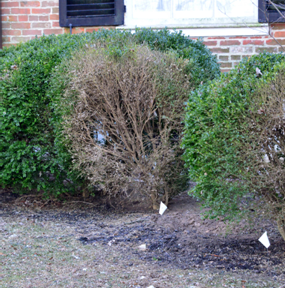Boxwood Blight
What is it?

Boxwood blight (also known as box blight and boxwood leaf drop) is a devastating fungal disease caused by the organism Cylindrocladium Buxicola and thrives in humid, warm conditions. Its contagious to other plants and ruins the appearance of boxwoods and pachysandras. The fungus can cause leaf loss and eventual death of the affected shrubs.
The first sign is round, brown spots on the leaves. The shrubs then drops most or all of its leaves and the twigs begin to die back. The roots are not affected, so the shrub may regrow. Plants don’t usually die of boxwood blight disease, but after repeatedly losing its leaves, it becomes so weak that it has no resistance to other diseases. Secondary infections usually attack and kill the plant. This disease is relatively newer to Wisconsin, it was first introduced to the state of July 2018.
How to Control Boxwood Blight
There is no cure for boxwood blight, so you must rely on disease prevention to protect the plant.

• Stay away from boxwood and pachysandra plants when they are wet.
• Disinfect your pruners between plants. Dip them in a solution of nine parts water and one part bleach for 10 seconds and then allow them to air dry. Scrub them thoroughly with soap and water and dry them before putting them away.
• Destroy or dispose of boxwood clippings. Never compost them unless you are sure your plants are disease-free.
• Avoid planting boxwoods in partly shaded areas.
The current recommendation is to remove and destroy the plant by burning it or double bagging and disposing of it. Do not plant boxwoods in areas where boxwood blight has been a problem in the past, as the fungus can survive in boxwood debris (e.g. leaves and branches) for several years.
To learn more about Boxwood Blight visit the University Of Wisconsin.
